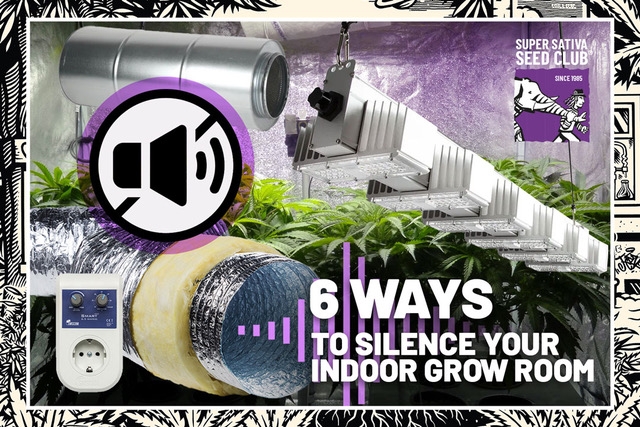
As a first time grower, after setting up all your equipment and turning everything on, you may be left surprised how loud and noisy your indoor garden is. Exhaust fans will blast air out of the ducting, oscillating fans will vibrate on the floors or tent poles, ballasts can make a constant humming sound, humming air pumps for hydro systems and some grow lights will use noisy internal fans to cool them. All of the above can equal an industrial sounding noise which may leave neighbors wondering what the noise is, so in this article we break down the 6 ways to silence your indoor grow room.
1. Passive cooled LED’s
The evolution of the horticultural growing light is certainly at its pinnacle, and with more LED companies emerging with top quality lights that excel in the spectrum and PAR department. As many growers make the jump from HPS to LED in the name of saving electricity and growing high grade buds, investing in the right lights that are well-made and are not noisy to run is not always easy.
Passive cooled light cases, such as SANlight LED, incorporate what is called passive cooling technology, meaning that the wasted heat energy provided by the lights, is able to pass through the metal casing and release the heat into the air. A complete upgrade to anyone who has used LED lights with internal fans which over time can gather dust, make a whirring sound or, in a worse case scenario, stop working completely.
Top Tip: LED lights can be expensive, so do plenty of research before investing and find out which brands offer the best solutions, in terms of passive cooled casings. SANlight LEDs are well recommended and produce excellent lights.
2. Acoustic Ducting
As air passes through ducting at a high speed, the sound created can be noisy and create a deep bass. Typical ducting will come as the cheap and cheerful, lightweight aluminum version. When using large sized exhaust and intake fans, the level of sound can be enough for a neighbor or house guests to hear some level of unwanted mysterious noise.
Acoustic ducting is a modified version which will have an asbestos or foam outer casing that creates a layer to block the sound of the passing air. The acoustic version will be much more expensive than regular basic ducting, however is well worth the investment in the long run, and when combined with silencers, acoustic wooden boxes work very well and can dramatically reduce the amount of noise generated by your setup.
Top Tip: Be Careful when setting up acoustic ducting as the asbestos or rockwool fiber inside can cause irritation and if breathed in can be harmful. Wear a face mask, goggles and gloves to prevent any type of reaction. You may end up spending three or four times the amount in comparison to the basic aluminum ducting, however over the long run the return on investment is well worth it.
3. Attach silencers
Silencers are made from a metal casing with a foam inline that is designed to allow air to pass through and to become absorbed into the soundproof foam inside. Silencers are created to be fixed to either side of the main exhaust fan, eliminating the noise levels, without affecting the efficiency of air flow. Available in different sizes depending on what equipment you are working with, silencers are one great way to give you an advantage in the grow room, and are considered another wise investment as they will last for a long time.
It is also a good idea to fix silencers to either side of the wooden acoustic boxes, which can be placed on the outside of the grow tent, in the event you do not have space inside. We personally recommend using two silencers, as a pair works far more effectively.
Top Tip: Silencers connected to ducting at either side of the exhaust fan will be the best way to reduce the noise produced by the exhaust fan. Inserting a silencer either side of the wooden acoustic boxes sitting on the floor is also another great method. Once bought, these well-made metal devices can be used for every grow without needing replacing over time.
4. Plug fan controller
You may have seen these devices and were sure of what they were, but fan controllers have a small dial on them and are pressed into the plug socket. By plugging in your exhaust fan and twisting the dial either left or right, you can choose the amount of power the exhaust fan will receive. Lowering the dial will reduce the air capacity that is generated by the fans, and as a result can lower the amount of noise produced by the passing air.
When working with large sized exhaust fans, turning them down by 25-30% capacity can make a very big difference as far as excess noise, without affecting the air flow per hour inside the tent too much. Plug fan controllers are an excellent way to lower the noise levels before sleeping for anyone who needs to sleep in the same room as their grow tent during the lights off part.
Top Tip: Using an exhaust fan that is much bigger than required for your grow tent, and reducing the power output, is one way to keep a high amount of air exchange and also lower sound levels significantly. Plug fan controllers are not expensive and can also be used for household appliances to help save electricity and your carbon footprint.
5. Wooden acoustic boxes
The custom sized wooden boxes have a soundproof foam inline, created to sit the exhaust fans. Wooden acoustic boxes are brilliant at reducing the noise produced by the loud RVK fans, and when combined with acoustic ducting and silencer, can really take the noise levels right down.
When setting up your indoor tent, you can simply sit the acoustic wooden box on the floor, and pass the ducting through the top of the tent, connected to your carbon filter. Wooden acoustic boxes can be expensive, and many growers choose to make their own version, ensuring the exhaust fan sits inside with no movement.
Top Tip: Some growers choose to hang these acoustic wooden boxes from the highest point in their tent, however we recommend sitting the box on the floor outside the tent, and connecting the acoustic ducting to the carbon filter hanging inside the tent. This provides much more room inside and reduces the amount of weight pulling down on the tent.
6. Fans
It is essential to create a consistent temperature and environment inside your grow room, and using fans is one way to achieve that. Wall fans, clip on fans or box fans designed to sit on the floor left on 24 hours a day, can produce a lot of noise and in some cases reverberation though the tent poles down to the ground.
One of the easiest ways to eliminate the concern of vibrating walls and tent poles, is to hang the fans from the above tent poles. You can use fabric straps or even a loose fitting cable tie to allow the fans to hang and rotate without making any unwanted vibration. Making this simple adjustment can stop a future problem with a close-by neighbor who is annoyed at the constant shaking walls or ceiling if you live in an apartment building.
Top Tip: If you are using small or large sized fans, then it is always best to use two fans and have them hanging at different points in the tent. One fan can be blowing at the lower parts of the canopy and another the top parts. If they are oscillating fans, then simply set them to rotate at different angles and times to create the ideal air flow.
(2312) (0)

